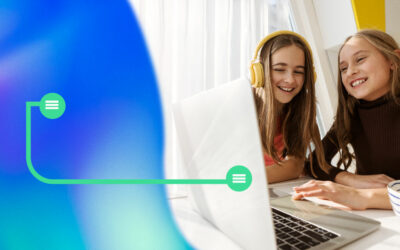If you’re starting out in your German language learning journey, having a firm grasp of the basics will be an excellent foundation to begin learning German. And what better place to build that solid foundation, than the German alphabet?
The German language is notorious for its sharp ‘S’ and ‘Ch’ sounds and long confusing sentences. You might look at German words like ‘Streichholzzschachtel’ or ‘Versuchskaninchen’ and naturally feel a little intimidated, but if you break down the German alphabet letters from A to Z, German pronunciation is actually quite logical!
In order to learn German, understanding German lettering is crucial, or as Germans like to say: It’s the A and O – the Alpha and the Omega, something like the magic key.
So in this article, we will break down each letter of the German alphabet for you and give you some tips on how to use them.
Why learn the German alphabet?
1. Each letter is worth it
One of the reasons German words can be so impressively long is because they tend to have a large variety of prefixes and suffixes. These can add an extra portion of meaning to each word. For example, the prefix ‘ver’ generally adds the meaning that something went wrong with a verb.
So while ‘laufen’ means ‘to run’, ‘verlaufen’ turns into ‘losing your way’ with the help of just three letters. Add the suffix ‘chen’ to a noun and a regular ‘Katze’ (cat) quickly becomes a ‘Kätzchen’, which entails the sense that it is small and pretty cute.
Just pick up one of Goethe’s original poems and marvel at just how detailed and precise the German language is. There may be many letters to juggle with but they do hold a lot of meaning!
2. Converse with 130 million people
German is the most widely spoken first language in the E.U. and one of the easiest languages for English speakers to learn, according to the FSI (Foreign Service Institute). Germans are also known to be some of the most well-traveled people in the world.
So if you don’t plan to travel to a German-speaking country, let the German speakers come to you! In case you don’t want to wait for that to happen, you can easily find a native speaker to practice with during an online language class with Berlitz.

3. You can already read it
The good news is: You already know how to read German letters. There are hundreds of writing systems in the world and English and German happen to share the same one, which is the Latin alphabet.
When learning many other languages like Mandarin, Hindi or Arabic, learners spend a lot of time learning the respective script before they can master its pronunciation. In German, you can at least recognize the letters and jump right into your first try of pronouncing them. Viel Glück!
German alphabet pronunciation
When wondering how to learn the German alphabet, you will find that most of the German consonants are luckily pronounced just like the English ones: B, D, F, H, K, L, M, N, P and X. There is some variation in the consonants C, G, J, Q, R, V, W, Y and Z but they are still fairly easy to recognize.
In general, German consonants are formed further back in the mouth and pronounced with a little more power of the tongue than the smooth English sounds. The biggest difference in German and English pronunciation can be found in the vowels though, as some of them are straight-up swapped. Here is a detailed table of how to pronounce each letter.
| Uppercase letter | Lowercase letter | Phonetic pronunciation |
| A | a | [aː] |
| B | b | [beː] |
| C | c | [tse] |
| D | d | [deː] |
| E | e | [eː] |
| F | f | [ɛf] |
| G | g | [geː] |
| H | h | [haː] |
| I | i | [iː] |
| J | j | [jɔt] |
| K | k | [kaː] |
| L | l | [ɛl] |
| M | m | [ɛm] |
| N | n | [ɛn] |
| O | o | [oː] |
| P | p | [peː] |
| Q | q | [kuː] |
| R | r | [ɛʁ] |
| S | s | [ɛs] |
| T | t | [teː] |
| U | u | [uː] |
| V | v | [faʊ] |
| W | w | [veː] |
| X | x | [ɪks] |
| Y | y | [‘ʏpsilɔn] |
| Z | z | [tsɛt] |
| Ä | ä | [ɛː] |
| Ö | ö | [øː] |
| Ü | ü | [yː] |
| – | ß | [ɛs’t͡sɛt] |
German alphabet songs
It is always helpful to listen to a recording when learning a language. So, when learning the German alphabet pronunciation, try the old-school method of learning the letters with a German alphabet song!
When learning something new, you will often feel like a kid trying to pick up the basics. Get used to the feeling with this catchy version of the German alphabet song for kids that teaches you the Abc in German as well as some animals.
Learn the alphabet military cadence style while you listen to this catchy chant. Repeat all the letters right away in this famous rhythm, then pick up the pace. Quick and efficient!
This is a funny version of the alphabet by German comedian and movie maker Elyas M’barek. His friend Sergej raps the alphabet with a bit of humor. What makes this video particularly helpful is that it doesn’t name the whole letters. Instead, it gives you the exact sound the letter usually makes in a word.
FAQs for the German alphabet
How do I get the German alphabet on my iPhone?
For iOS, go to Settings > General > Keyboard. Tap “Keyboards”, then tap “Add New Keyboard.” Select “German” from the list and switch between the English and the German keyboard by swiping the space bar when typing.
How do I get the German alphabet on my Android?
Go to Settings > General Management > Language and Input > On-screen Keyboard > Samsung Keyboard, tap “Language and Types”, then tap “Manage input languages” and select “German” from the list. Switch between the English and the German keyboard by swiping the space bar when typing.
How many letters are in the German alphabet?
30
Which letters are unique to the German alphabet?
Ä, Ö, Ü are letters that do not exist in English, but they appear in Hungarian, Turkish and other languages, while the ß is truly unique to German.
Tips to learning the German alphabet
1. Rely on similarities
Just like English, German is part of the West Germanic Language Family, which means that the two used to be dialects of the same common language. Those dialects used to be mutually intelligible until the 8th century CE.
Much has happened since then and you have probably noticed that English and German are not exactly mutually comprehensible anymore. However, if you pay close attention when reading and listening to German, you will notice all the many similarities that can help you make sense of the language.
2. Get used to the unknown
While all 26 letters of the English alphabet are also found in German, you will encounter four completely new ones as well: Ä, Ö, Ü and ß. The trick in each case is just a slight adjustment of the lips.
For the ‘Ä’, say ‘ey’ but cut the word in half stopping right after you started. For the ‘Ö’ make the same sound but with your lips pursed into an ‘O’ shape and for the ‘Ü’, try saying ‘U’ as if you’re whistling. The ‘ß’ may look strange but it is simply a sharp ‘S’, called ‘SZ’ in German.
3. Have a native or fluent speaker literally spell it out for you

As all of this is hard to explain, it is better to listen to a native-fluent speaker make those sounds for you. Whether you’re in a language tandem or have your own personal online instructor, it really helps to have a native speaker around, who can correct your pronunciation and spell words for you. So grab a partner and when you learn new vocabulary, don’t be afraid to ask them to spell each letter. Your ears will soon get attuned to the German alphabet and its pronunciation.
4. Master the ‘Ch’
Confusing the ‘Ch’ sound with the ‘K’ sounds is possibly the most common error English speakers make when learning German. In English, the ‘Ch’ is pronounced in the front of the mouth, as in ‘church’. In German, however, there are two variations of the ‘Ch’ sound, both of which are pronounced in the back of the mouth.
The ‘Ch’ in ‘ich’ is pronounced on the back bottom of the mouth, while the ‘ch’ in ‘machen’ is pronounced harsher and even further in the back, almost in the throat, which in German, very fittingly is called ‘Rachen’ and has exactly that sound in it.
As letters make words and words make up languages…
Then, the alphabet is the natural starting point when learning a new language. As you learned, German is not all that different from English and the differences you do encounter are actually quite fascinating.
You can learn even more about the German language in one of our German classes as reading about the alphabet and its pronunciation is a great start but what actually helps with language learning is going out there and practicing with someone.
Pronunciation is key to conversation and conversing is the most fun way to engage with a new language. So go out there and practice some of those long and special German words!


